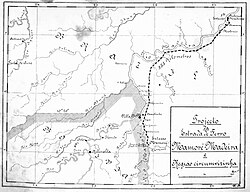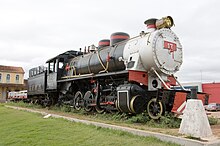Madeira-Mamoré Railway
| Madeira-Mamoré Railway | |||||||||||||||||
|---|---|---|---|---|---|---|---|---|---|---|---|---|---|---|---|---|---|
| Route length: | 364.4 km | ||||||||||||||||
| Gauge : | 1000 mm ( meter gauge ) | ||||||||||||||||
|
|||||||||||||||||
The Madeira-Mamoré Railway (EFMM - Estrada de Ferro Madeira-Mamoré) was a 364 km long railway line in Brazil . Until around 2000, a short section of the route between Santo Antônio and Porto Velho was still in operation for tourists.
During the time of the Brazilian rubber boom, it was supposed to run from the Bolivian city of Riberalta via the Brazilian border town of Guajará-Mirim on the Río Mamoré , on to Porto Velho, on the Rio Madeira and was intended for the transport of rubber , as the Madeira does not exist in this part was navigable. The construction was only carried out from Guajará-Mirim to Porto Velho, although the Bolivian section was part of the Petrópolis Treaty and Bolivia wanted to participate in the rubber boom.
The plan to build a railway line here was put forward in 1869 by the German engineer Franz Keller . The rapids along the Rio Madeira between Río Mamoré and Porto Velho were to be bypassed and thus create access for Bolivia's raw materials to the Atlantic. The construction of the railway through the jungle began as early as 1872. However, when, after three years, only part of the route had been cleared and not a meter of track had been laid, work had to be stopped. Two further attempts to resume work also failed. Only 40 years after the first start of construction, after construction had been resumed by a US company in 1907, the line was opened on August 1, 1912.
The work on the route was tough and cost many lives. It is said that for every threshold that could be laid, a worker died. Even if this tradition seems highly exaggerated, more than 6,000 workers are officially recorded who were killed during the construction work. It does not include the victims of the indigenous tribes who were affected by the construction of the railroad through their area. Above all, it was tropical storm disasters, snakes and mosquito- borne diseases, as well as clashes with the indigenous people, which claimed the lives of the jungle as it opened up. They are the starting point for numerous legends that revolve around the construction of the railway. The ghosts of deceased workers are said to have appeared to the locomotive drivers, from whom they demanded a ride.
Soon after the railway opened, the rubber boom subsided and the railway line had to be closed.
The company had 22 steam locomotives from Europe and the USA in service.
Along the way you can still see some steam locomotives overgrown by plants. The former terminus in Porto Velho functions as a small museum. The railway was also in operation as a tourist attraction between Guajará-Mirim and Iata from 1981 to 1991.
In 1980 the novel "Mad Maria" by Marcio Souza was published . The topic is the construction of the railway along the Rio Madeira.
The EFMM depot in Porto Velho has been entered in the register of nationally important cultural monuments since 2008 .
literature
- Madeira Mamoré Railway . In: Victor von Röll (Ed.): Encyclopedia of the Railway System . tape 7 , 1915, pp. 240 ( zeno.org [accessed October 16, 2017]).
- Richard Hennig : The Madeira-Mamoré Railway . In: Archives for railways . 1914, p. 163-167 .
- Manoel Rodrigues Ferreira: A Ferrovia do Diabo . 6th edition. Editora Melhoramentos, São Paulo 2008, ISBN 85-06-04476-6 (Brazilian Portuguese, original title: A Ferrovia do Diabo . 1959.).
Movie
- SWR: Railway Romanticism - The Death Railway. Out and about in the wild west of Brazil (eps. 440)
Web links
- Homepage of the Associação dos Amigos da Madeira-Mamoré and the Madeira-Mamoré Railway Society (English) ( Memento from July 23, 2011 in the Internet Archive )
- netzeitung.de Forgotten rubber train in the rainforest ( Memento from September 29, 2007 in the Internet Archive )
- The Railways of Brazil
- Estrada de Ferro Madeira Mamoré. Archived from the original on October 26, 2009 ; Retrieved October 16, 2017 (Portuguese).


